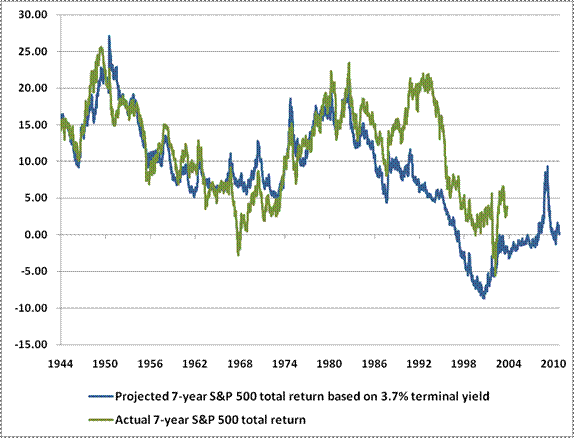ARE YOU READY FOR EQUITY RETURNS OF -0.07%?
Courtesy of The Pragmatic Capitalist
In February of 2009 John Hussman wrote a letter that stood out to me. He discussed the very depressed valuations and the likelihood of 9-11% 10 year returns. This was a big change for Mr. Hussman and a very healthy 10 year return by any standard. What no one expected, however, was that we would get most of that 10 year return in just 10 months.
In his latest letter Mr. Hussman updated his valuation model. It’s not nearly as optimistic:
Total annual return = (1+g)(Yoriginal/Yterminal)^(1/T) – 1 + (Yoriginal+Yterminal)/2
As it happens, the long-term growth rates of S&P 500 dividends, earnings (measured peak-to-peak across economic cycles) and other fundamentals have been remarkably stable for more than 70 years, at about 6% annually, with very little variation even during the inflationary 1970′s. Even if one includes the depressed yields of the bubble period, and restrict history to the post-war period, the median dividend yield is 3.7%. Thus, a reasonably good estimate of future 7-year total returns for the S&P 500 is simply:
Total annual return = (1.06)(Yoriginal/.037)^(1/7) – 1 + (Yoriginal + .037)/2
At a 2% dividend yield, this estimate is currently -0.07%.
For historical perspective, the chart below presents the 7-year projected total returns obtained in this manner in blue. The actual subsequent 7-year total return for the S&P 500 is depicted in green. Notice that the performance of this method deteriorated significantly after about 1988, reflecting the fact that terminal yields 7 years later began to depart dramatically from prior historical norms.

The last 15 years have been skewed to the upside as the U.S. government has attempted to generate a capitalist market where losers never lose. In other words, valuations have been inappropriately bolstered by the government’s constant tinkering in the markets:
“The difference between the green line and the red line represents the effect of bubble valuations. Had it not been for a period of sustained bubble valuations (which ultimately proved themselves to be bubble valuations by creating a 13 year period of dismal subsequent returns), we find that the yield-based model above would have extended its admirable historical record.
This creates a terrible problem for investors here. Given that the yield on the S&P 500 is now below 2%, it is essential for investors to recognize that they now rely on the achievement and maintenance of sustained bubble valuations in the years ahead. Unless investors believe that bubble valuations can be maintained indefinitely, they can expect little but abysmal returns over the coming 5- 7 year period.”
Mr. Hussman doesn’t parse words here. He again refers to the current economic environment as being similar to a ponzi scheme:
“The global financial system continues to be unsound in the same way that a Ponzi scheme is unsound: there are not enough cash flows to ultimately service the face value of all the existing obligations over time. A Ponzi scheme may very well be liquid, as long as few people ask for their money back at any given time. But solvency is a different matter – relating to the ability of the assets to satisfy the liabilities.”
Source: Hussman Funds


